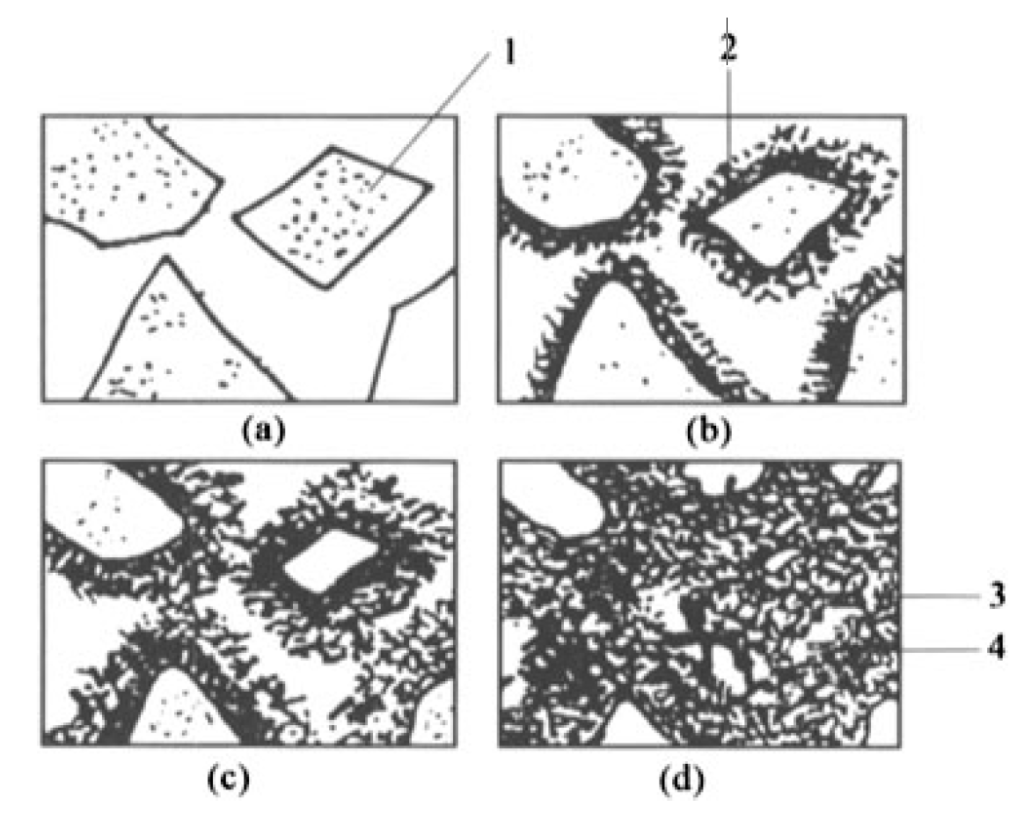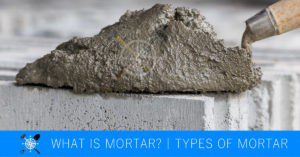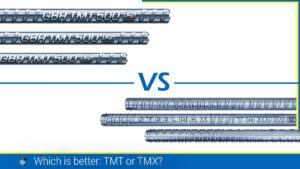Cement is the basic ingredient of concrete, mortar and plaster which consists of a mixture of oxides of calcium, silicon and aluminium. This article on Portland Cement discusses its composition, manufacturing process, properties, type, uses, etc.
What is Portland Cement?
Portland cement is a generic term used to describe any type of hydraulic cement that is produced by heating a mixture of limestone and clay or limestone and shale in a kiln to a high temperature of 1,450 °C. Then the resulting clinker is ground to a fine powder which is known as Portland Cement.
The name “Portland” comes from the fact that the cement is made to resemble a type of limestone quarried in Portland, England. It was first patient by Joseph Aspdin British stone mason in 1824 in England. Aspidin burnt finely ground limestone and clay in a kiln at very high temperatures which set and gain strength in coming contact with water. He then named it Portland cement which is a hydraulic property in nature.
Usually, cement is grey, with an average particle size of approximately 45μm (Mehta. p427. 2010). However, other colour variations are also made as White Portland cement, which contains little or no iron or manganese.
Composition of Portland Cement
The major raw material required is clay or shale. Clay consists of the oxides of silicon, aluminium and iron whereas, shale is a highly compressed form of clay. Limestone comprises approximately two-thirds of the raw material required for making cement.
Portland cement consists of four major clinker compounds, Tricalcium Silicate (C3S), Dicalcium Silicate (C2S), Tricalcium Aluminate (C3A), and Tetracalcium Aluminoferrite (C4AF) together with the gypsum added during grinding.
| Sl.No. | Clinker Compound | By Weight |
|---|---|---|
| 1. | Tricalcium Silicate (C3S) | 40% |
| 2. | Dicalcium Silicate (C2S) | 30% |
| 3. | Tricalcium Aluminate (C3A) | 11% |
| 4. | Tetracalcium Aluminoferrite (C4AF) | 11% |
Manufacturing Process of Portland Cement
The process used to manufacture modern Portland cement is essentially identical to the process used by Aspidin, as it involves heating a blend of limestone and clay, which are the same fundamental raw materials.
The manufacturing of cement begins with the quarrying of limestone and crushing it into smaller pieces is the initial stage. Crushed limestone and other fundamental raw materials (clay, sand and iron) are stored in silos which are later processed according to needs. These raw materials are mixed together in the proportion stipulated to gain the desired cement types.
The raw materials are then ground into a fine powder in a grinding mill. The fine powder is taken to a rotatory kiln which is heated at 1450 °C where calcium carbonate is converted to calcium oxide. Later at the end of the rotatory kiln where the temperature is much higher, calcium oxide reacts with other raw materials to form a calcium compound which is partially a molten form. The clinker is cooled and stored in a silo.
The cooled clinker is mixed with a small quantity of gypsum, The clinkers and gypsum are ground and blended into a very fine powder which is called Portland cement. The addition of gypsum will help in controlling the setting time of the cement.
Hydration of Cement
When water is added to cement, the particles become encased in water, and the surface of the mineral granules in the clinker reacts instantly with the water. This reaction generates a series of new compounds and releases a certain amount of heat. The process can be represented as follows:
2(3CaOSiO2)+6H2O=3CaO.SiO2.3H2O+3Ca(OH)2
2(2CaO.SiO2)+4H2O=3CaO.2SiO2.3H2O+Ca()H)2
3Ca.Al2O3+6H2O=3CaO.Al2O3.6H2O
4CaO.Al2O3.Fe2O3+7H2O=3CaO.Al2O3.6H2O+CaO.Fe.O3.H2O
To control the setting time of cement, a small amount of gypsum (approximately 3%) is added during the grinding of the clinker. The gypsum reacts with a portion of the calcium aluminate hydrate, forming insoluble needle-like crystals of calcium sulfate hydrate, which exhibit significant cubic expansion.
3CaO.Al2O.6H2O+3(CaSO4.2H2O)+19H2O)+19H2O=3CaO.Al.2O3.3CaSO4.31H2O
In summary, when Portland cement reacts with water, it produces hydrates primarily composed of calcium silicate hydrate, calcium ferrite hydrate gel, calcium aluminate hydrate, and calcium sulfate hydrate crystals. In fully hydrated cement paste, calcium silicate hydrate makes up about 50%, while calcium hydroxide constitutes around 25%.
Setting and Hardening of Cement
When cement is mixed with water, the particles react immediately, forming colloidal hydrated products that accumulate on their surfaces. This accumulation slows down the chemical reactions and gives the paste its plasticity. The hydrated products dissolve, exposing fresh surfaces for further hydration. As more colloidal products form, they create a loose mesh structure, which causes the paste to lose its mobility and plasticity—this is known as the setting of cement.
As hydration progresses, calcium silicate hydrate gel, calcium hydroxide, and other hydrated products increase in quantity and adhere to one another, forming a denser mesh structure that strengthens the cement. Over time, the unhydrated inner portions of the cement granules continue to hydrate, producing more crystals and densifying the gel. This process enhances the bonding capacity and strength of the cement paste, known as the “hardening” of cement.
After hardening, the cement paste transforms into a heterogeneous structure composed of crystals, gel, unhydrated clinker particles, free water, and pores of various sizes, as illustrated in Figure below.

The ratio of crystals, gel, and unhydrated granules in cement paste at different stages of the hardening process significantly impacts its strength and properties. Additionally, the strength of the cement is influenced by temperature and moisture levels. Higher moisture increases hydration speed, leading to faster setting and hardening, while lower moisture slows these processes. In a completely dry state, hydration ceases, halting hardening and preventing strength development. Therefore, it is crucial to maintain proper watering after concrete structures are cast. When temperatures drop below 0°C, hydration nearly stops, so insulating measures should be implemented during winter construction to ensure the hardening process continues effectively.
Also, read: Ordinary Portland Cement: Properties, Composition, Manufacturing and Uses
Properties of Portland Cement
- Finenss:
Fineness refers to the sizes of cement particles, influencing both the performance and application of the cement. Cement fineness is measured by either the sieve analysis method or by determining the specific surface area. The sieve analysis method mandates that the residue on the 0.080mm square-hole sieve should not surpass 10%. Specific surface area is computed based on the total surface area of 1 kg of cement (m2/kg). For Portland cement, the specific surface area should be greater than 300 m2/kg.
- The Setting Time:
The setting time of cement includes the initial setting time and the final setting time. The initial time refers to the time that cement turns into a paste by mixing with water and begins to lose its plasticity. The time that cement completely loses its plasticity by mixing with water and begins to have a certain structural strength is known as the final setting time.
The initial setting time of Portland cement should not be earlier than 30 minutes and the final setting time should not be later than 6.5 hours. The setting time of cement is measured by a time determinator. The sample is the standard cement paste of which the temperature is 20°C ± 3°C and humidity is more than 90%.
The initial setting time should not be too fast in order to ensure that there is enough time to complete every process, such as casting, before the initial setting time; and the final setting time should not be too late in order to enable the cement to complete its setting and hardening as soon as possible after pouring and tamping to make the next process occur earlier.
- Soundness:
The cement is said to be unsound if it exhibits volumetric instability after hardening. IS code recommends testing with Le Chatelier mould for testing this property. At the end of the test, the indicator of Le Chatelier mould should not expand by more than 10 mm.
- Crushing strength:
For this mortar cubes are made with standard sand and tested in a compression testing machine as per the specification of the IS code. The minimum strength specified is 16 N/mm2 after 3 days and 22 N/mm2 after 7 days of curing
- Alklin Content:
The alkali content in cement is indicated by the presence of Na2O and K2O. The prerequisite for the alkali-aggregate reaction to occur in concrete is that the cement must include alkali. When the active aggregate material is used, the cement with low alkali content should be used. The alkali content in cement should not exceed 0.60% or can be determined by the two sides of supply and demand.
Types of Portland Cement
According to ASTM C150, which is a standard specification for Portland cement, there are five types of Portland cement manufactured that are classified based on their physical and chemical properties which are altered in very small quantities. The main types are:
Type I – This is the most common type of cement and is used for general construction purposes. It is suitable for use in concrete, mortar, and other building applications.
Type II – This type of cement is designed to produce concrete that is more resistant to sulfates and other chemical attacks. It is commonly used in structures that are exposed to soil and water containing sulfates.
Type III – This type of cement is used when a fast-setting time is required, such as in precast concrete applications. It has a higher early strength than Type I or Type II cement.
Type IV – This type of cement is used in massive concrete structures where heat buildup can cause cracking. It generates less heat during hydration than Type I, Type II, or Type III cement.
Type V – This type of cement is used in high-sulfate environments such as seawater and soil with high sulfate concentrations. It has the highest resistance to sulphate attacks among all types of cement.
Also, read: Portland Pozzolana Cement: Properties | Advantages | Uses
Types and Their Uses
| Portland Cement | Uses |
|---|---|
| Type I | General-purpose cement, is used where there is no special requirement |
| Type II | Sulfate-resistant cement is used where high sulfate resistance is required |
| Type III | High-early-strength cement is used in precast elements and where high early strength is required, such as in cold weather |
| Type IV | Low-heat-of-hydration Portland cement, used in massive civil engineering structures |
| Type V | Sulfate-resistant cement is used where high sulfate resistance is required |
Also, read: White Portland Cement: Properties, Applications, Advantages, Disadvantages
FAQs:
Q: What is Portland Cement?
Ans: It is a hydraulic cement which was patented in 1824 by Joseph Aspidin. It is produced by heating a mixture of limestone and clay in a kiln to a high temperature of 1,450 °C. Then the clinker is ground to a fine powder which is known as Portland Cement. It has a wide range of applications in construction work.
Q: What is the difference between Portland Cement and OPC?
Ans: Portland cement is a generic term used to describe hydraulic cement that includes several different types of cement. Whereas, OPC (Ordinary Portland cement) is a type of hydraulic cement or Portland cement that is distinguished by the amount of composition in it.
Q: Why is a limited amount of gypsum added to Portland cement clinker?
Ans: A limited amount of gypsum (typically around 3%) is added to Portland cement clinker to regulate the setting time of the cement. Gypsum reacts with calcium aluminate hydrate in the clinker to form insoluble calcium sulfate hydrate crystals. This reaction helps to control the hydration process, preventing the cement from setting too quickly. By managing the setting time, gypsum allows for better workability and handling of the cement paste during construction, ensuring that it can be effectively placed and finished before hardening occurs.
References:
- Mehta, M., Scarborough, W., & Armpriest, D. (2017). Building constructions: Principles, materials, and systems. Pearson Education, Inc.
- Zhang, H. (Ed.). (2011). Building Materials in Civil Engineering (1st ed.). Woodhead Publishing Limited. https://shop.elsevier.com/books/building-materials-in-civil-engineering/zhang/978-1-84569-955-0
- Portland cement. (2023, March 25). In Wikipedia. https://en.wikipedia.org/wiki/Portland_cement
- Britannica, T. Editors of Encyclopaedia (2023, April 21). portland cement. Encyclopedia Britannica. https://www.britannica.com/technology/portland-cement
- Portland Cement Association. https://www.cement.org/cement-concrete/cement-and-concrete-basics-faqs/lists/cement-concrete-basics-faqs/are-there-different-types-of-portland-cement- Cement & Concrete Basics FAQs.
![]()







